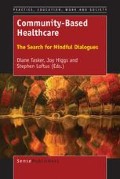Abstract
Interactions between people getting to know each other and working together can be seen as strongly narrative in nature. Narrative places emphasis on temporality (events occurring over time) and the telling of those events (Rimmon-Kenan, 2006). In this chapter, the concepts of story and narrative inform the author’s research into community-based physiotherapeutic relationships, arguing that stories are an essential part of human relationships.
Access this chapter
Tax calculation will be finalised at checkout
Purchases are for personal use only
Preview
Unable to display preview. Download preview PDF.
References
Alsaker, S., & Josephsson, S. (2009). Occupation and meaning: Narratives in everyday activities of women with chronic rheumatic conditions. Occupational Therapy Journal of Rehabilitation, 30(2), 58-67.
Aristotle. (1996). Poetics (M. Heath, Trans.). Harmondsworth: Penguin.
Bakhtin, M. (1981). The dialogic imagination: Four essays (M. Holquist, Ed., C. Emerson & M. Holquist, Trans.). Austin: University of Texas Press.
Baumeister, R. F., & Vohs, K. D. (2002). Meaningfulness in life. In C. R Snyder & S. J. Lopez (Eds.), Handbook of positive psychology (pp. 608-618). Oxford: Oxford University Press.
Bruner, J. (1990). Acts of meaning: Four lectures on mind and culture. Harvard, CT: Harvard University Press.
Charon, R. (2006). Narrative medicine: Honoring the stories of illness. Oxford: Oxford University Press.
Frank, A. W. (1995). The wounded storyteller. Chicago: The University of Chicago Press.
Greenhalgh, T. (1999). Narrative based medicine: Narrative based medicine in an evidence based world. British Medical Journal, 318(7179), 323-325.
Greenhalgh, T. (2006). What seems to be the trouble: Stories in illness and healthcare. Oxford: Radcliffe.
Hausheer, H. (1937). St. Augustine’s conception of time. The Philosophical Review, 46(5), 503-512.
Herman, D. (Ed.). (2007). The Cambridge companion to narrative. Cambridge: Cambridge University Press.
Herrnstein Smith, B. (1981). Narrative versions, narrative theories. In W. J. T. Mitchell (Ed.), On narrative. Chicago: The University of Chicago Press.
Hovey, R., & Paul, J. (2007). Healing, the patient narrative-story and the medical practitioner: A relationship to enhance care for the chronically ill patient. International Journal of Qualitative Methods, 6(4), 1-14. Retrieved from http://ejournals.library.ualberta.ca/index.php/IJQM/article/view/9810
Kearney, P. (2009). Reconfiguring the future: Stories of post-stroke transition (Unpublished PhD thesis). University of South Australia, Adelaide.
Loftus, S., & Greenhalgh, T. (2010). Towards a narrative mode of practice. In J. Higgs, D. Fish, I. Goulter, S. Loftus, J-A. Reid, & F. Trede (Eds.), Education for future practice (pp. 85-97). Rotterdam: Sense.
Merleau-Ponty, M. (1964). The primacy of perception. Evanston, IL: Northwestern University Press.
Nicholls, D. A., & Gibson, B. (2010). The body and physiotherapy. Physiotherapy Theory and Practice, 26(8), 497-509.
Nicholls, D., & Holmes, D. (2012). Discipline, desire, and transgression in physiotherapy practice.Physiotherapy Theory and Practice, 28(6), 454-465.
Noriega Sanchez, M. R. (1998). A Bakhtinian reading of William Faulkner’s “As I lay dying”. Revista de Estudios Norteamericanos, 6, 51-67. Retrieved from http://institucional.us.es/revistas/estudios/6/art_4.pdf
Øien, A. M., Iversen, S., & Stensland, P. (2007). Narratives of embodied experiences: Therapy processes in Norwegian psychomotor physiotherapy. Advances in Physiotherapy, 9(1), 31-39.
Paley, J., & Eva, G. (2005). Narrative vigilance: The analysis of stories in healthcare. Nursing Philosophy, 6(2), 83-97. Porter Abbott, H. (2008). The Cambridge introduction to narrative (2nd ed.). Cambridge, UK: Cambridge University Press.
Ricoeur, P. (1983a). Narrative and time (Vol. 1). Chicago: The University of Chicago Press.
Ricoeur, P. (1983b). Narrative and time (Vol. 2). Chicago: The University of Chicago Press.
Rimmon-Kenan, S. (2006). Concepts of narrative. Retrieved from http://hdl.handle.net/10138/25747
Skott, C. (2001). Caring narratives and the strategy of presence: Narrative communication in nursing practice and research. Nursing Science Quarterly, 14(3), 249-254.
Sorrell, J., & Redmond, G. (2002). Community-based nursing practice: Learning through students’ stories. Philadelphia: FA Davis.
Soundy, A., Smith, B., Cressy, F., & Webb, L. (2010). The experience of spinal cord injury: Using Frank’s narrative types to enhance physiotherapy undergraduates’ understanding. Physiotherapy, 96(1), 52-58.
Titchen, A., & Hobson, D. (2005). Phenomenology. In B. Somekh & C. Lewin (Eds.), Research methods in the social sciences (pp. 121-130). London: Sage.
Varela, F., Thompson, E., & Rosch, E. (1997). The embodied mind. Cambridge, MA: MIT Press.
Author information
Authors and Affiliations
Editor information
Editors and Affiliations
Rights and permissions
Copyright information
© 2017 Sense Publishers
About this chapter
Cite this chapter
Tasker, D. (2017). Narrative as a Lens on Practice. In: Tasker, D., Higgs, J., Loftus, S. (eds) Community-Based Healthcare. Practice, Education, Work and Society. SensePublishers, Rotterdam. https://doi.org/10.1007/978-94-6300-995-9_3
Download citation
DOI: https://doi.org/10.1007/978-94-6300-995-9_3
Publisher Name: SensePublishers, Rotterdam
Online ISBN: 978-94-6300-995-9
eBook Packages: EducationEducation (R0)

